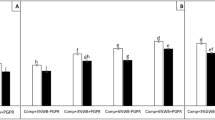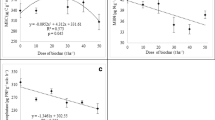Abstract
The addition of biochar to the soil has been seen as a potential and low-cost important tool in the management of tomato diseases.
Thus, the objective of this study was to evaluate the effect of biochar from different sources applied to the sandy soil against bacterial wilt disease caused by Ralstonia solanacearum in tomatoes.
We set up two experiments: (1) To evaluate the impact of different sources of biochar: cassava husk (CHB), bean straw (BPB), sugar cane straw (SSB), and corn straw (CPB) in reducing the growth of the R. solanacearum in vitro; and (2) To evaluate the effect of the use of these biochars applied to the soil on reducing the severity of bacterial wilt in tomatoes.
The different sources of biochar are efficient in reducing the formation of colony-forming units of R. solanacearum. CHB reduced the growth of the bacterium by 19%, followed by CPB and BPB, which showed an approximate reduction of 16% and 13%, respectively. Biochar BPB and CHB applied to the sandy soil were able to reduce the severity of bacterial wilt in tomatoes by 30%.
Overall, our findings expand our knowledge about the reuse of wastes transformed in biochar that has potential perspective to formulate products as alternative management tool as management of bacterial wild (R. solanacearum) in tomato and add important information that can be suitable for development of strategy for use in the global health concept.



Similar content being viewed by others
References
Ali A, Guo D, Jeyasundar PGSA, Li Y, Xiao R, Du J, Zhang Z (2019) Application of wood biochar in polluted soils stabilized the toxic metals and enhanced wheat (Triticum aestivum) growth and soil enzymatic activity. Ecot Environ Safety 184:109635. https://doi.org/10.1016/jecoenv2019109635
Bai W, Kong F, Lin Y, Zhang C (2016) Extract of Syringa oblata: a new biocontrol agent against tobacco bacterial wilt caused by Ralstonia solanacearum. Pest Bioch Phys 134:79–83. https://doi.org/10.1016/jpestbp201604002
Bonanomi G, Ippolito F, Scala F (2015) A “black” future for plant pathology? Biochar as a new soil amendment for controlling plant diseases. J Plant Pathol 97:223–234. https://doi.org/10.4454/jppv97i23381
Buss W, Shepherd JG, Heal KV, Mašek O (2018) Spatial and temporal microscale pH change at the soil-biochar interface. Geoderma 331:50–52. https://doi.org/10.2134/jeq2018050181
Chen S, Qi G, Ma G, Zhao X (2020) Biochar amendment controlled bacterial wilt through changing soil chemical properties and microbial community. Microbiol Research 231:126373. https://doi.org/10.1016/jmicres2019126373
Dai Y, Zheng H, Jiang Z, Xing B (2020) Combined effects of biochar properties and soil conditions on plant growth: a meta-analysis. Sci Total Environ 713:136635. https://doi.org/10.1016/jscitotenv2020136635
Debode J, Ebrahimi N, D’hose T, Cremelie P, Viaene N, Vandecasteele, B (2020) Has compost with biochar added during the process added value over biochar or compost to increase disease suppression? App Soil Ecol 153:103571. https://doi.org/10.1016/japsoil2020103571
Eivazi F, Tabatabai MA (1977) Phosphatases in Soils Soil Biol Bioch 9:167–172. https://doi.org/10.1016/0038-0717(77)90070-0
Graber ER, Frenkel O, Jaiswal AK, Elad Y (2014) How may biochar influence severity of diseases caused by soilborne pathogens? Carbon Manag 5:169–183. https://doi.org/10.1080/175830042014913360
Gu Y, Hou Y, Huang D, Hao Z, Wang X, Wei Z, Friman VP (2017) Application of biochar reduces Ralstonia solanacearum infection via effects on pathogen chemotaxis, swarming motility, and root exudate adsorption. Plant Soil 415:269–281. https://doi.org/10.1007/s11104-016-3159-8
James D, Mathew SK (2017) Compatibility studies on different endophytic microbes of tomato antagonistic to bacterial wilt pathogen. Int J Adv Biotechnol Res 7:190–194
Jaiswal AK, Elad Y, Graber ER, Frenkel O (2014) Rhizoctonia solani suppression and plant growth promotion in cucumber as affected by biochar pyrolysis temperature, feedstock and concentration. Soil Biol Bioch 69:110–118. https://doi.org/10.1016/jsoilbio201310051
Jaiswal AK, Graber ER, Elad Y, Frenkel O (2019) Biochar as a management tool for soilborne diseases affecting early stage nursery seedling production. Crop Protec 120:34–42. https://doi.org/10.1016/jcropro201902014
Kandeler E, Gerber H (1988) Short-term assay of soil urease activity using colorimetric determination of ammonium. Biol Fert Soils 6:68–72. https://doi.org/10.1007/BF00257924
Katan J (2017) Diseases caused by soilborne pathogens: biology, management and challenges. J Plant Pathol 99:305–315. https://doi.org/10.4454/jpp.v99i2.3862
Kavitha B, Reddy PVL, Kim B, Lee SS, Pandey SK, Kim KH (2018) Benefits and limitations of biochar amendment in agricultural soils: a review. J Environ Manag 227:146–154. https://doi.org/10.1016/j.jenvman.2018.08.082
Lima JRS, Goes MCC, Hammecker C, Antonino ACD, Medeiros EV, Sampaio EVSB, Leite MCBS, Silva VP, Souza ES, Souza R (2021) Effects of poultry manure and biochar on Acrisol soil properties and yield of common bean. A Short-Term Field Experiment Agriculture 11:290. https://doi.org/10.3390/agriculture11040290
Lima JRS, Silva WM, Medeiros EV, Duda GP, Corrêa MM, Martins Filho AP, Clermont-Dauphin C, Antonino ACD, Hammecher C (2018) Effect of biochar on physicochemical properties of a sandy soil and maize growth in a greenhouse experiment. Geoderma 319:14–23. https://doi.org/10.1016/jgeoderma201712033
Mandal S, Donner E, Smith E, Sarkar B, Lombi E (2019) Biochar with near-neutral pH reduces ammonia volatilization and improves plant growth in a soil-plant system: a closed chamber experiment. Sci Total Environ 697:134114. https://doi.org/10.1016/jscitotenv2019134114
Medeiros EV, Lima NT, de Sousa LJR, Pinto KMS, da Costa DP, Junior CLF, Hammecker C (2021) Biochar as a strategy to manage plant diseases caused by pathogens inhabiting the soil: a critical review. Phytoparasitica 1:1–14. https://doi.org/10.1007/s12600-021-00887-y
EV Medeiros MC Moraes DP Costa JS Silva JB Oliveira RS Lima C Hammecker 2020 Biochar and Trichoderma aureoviride applied to the sandy soil: effect on soil quality and watermelon growth Not Bot Horti Agrobot 48 735 751 https://doi.org/10.15835/nbha48211851
Mendiburu F (2021) Agricolae: statistical Procedures for Agricultural Research. R package version 1.3–5. https://CRAN.R-project.org/package=agricolae
Mohammed AF, Oloyede AR, Odeseye AO (2020) Biological control of bacterial wilt of tomato caused by Ralstonia solanacearum using Pseudomonas species isolated from the rhizosphere of tomato plants. Arch Phytopathol Plant Protect 53:1–2. https://doi.org/10.1080/03235408.2020.1715756
Morais TP, Zaini PA, Chakraborty S, Gouran H, Carvalho CP, Almeida-Souza HO, Dandekar AM (2019) The plant-based chimeric antimicrobial protein SlP14a-PPC20 protects tomato against bacterial wilt disease caused by Ralstonia solanacearum. Plant Sci 280:197–205. https://doi.org/10.1016/jscitotenv2019134114jplantsci201811017
Nion YA, Toyota K (2015) Recent trends in control methods for bacterial wilt diseases caused by Ralstonia solanacearum. Micr Environm ME14144. https://doi.org/10.1264/jsme2ME14144
Oksanen J, Blanchet FG, Friendly M, Kindt R, Legendre P, McGlinn D, Minchin PR, O'Hara RB, Simpson GL, Solymos P, Stevens MHH, Szoecs E, Wagner H (2020) Vegan: community ecology package. R package version 2.5–7. https://CRAN.R-project.org/package=vegan
Pandey D, Daverey A, Arunachalam K (2020) Biochar: production, properties, and emerging role as a support for enzyme immobilization. J Clean Prod 255:2020. https://doi.org/10.1016/j.jclepro.2020.120267
Postma J, Nijhuis EH (2019) Pseudomonas chlororaphis and organic amendments controlling Pythium infection in tomato. Europ J Plant Pathol 154:91–107. https://doi.org/10.1007/s10658-019-01743-w
Rasool M, Akhter A, Soja G, Haider MS (2021) Role of biochar, compost and plant growth promoting rhizobacteria in the management of tomato early blight disease. Sci Reports 11:1–16
Rivera-Utrilla J, Bautista-Toledo I, Ferro-García MA, Moreno-Castilla C (2001) Activated carbon surface modifications by adsorption of bacteria and their effect on aqueous lead adsorption. J Chem Tech Biotech 76:1209–1215. https://doi.org/10.1002/jctb506
Singh S, Gautam RK, Singh DR, Sharma TVRS, Sakthivel K, Roy SD (2015) Genetic approaches for mitigating losses caused by bacterial wilt of tomato in tropical islands. Europ J Plant Pathol 143:205–221. https://doi.org/10.1007/s10658-015-0690-z
Silva CCG, Medeiros EV, Fracetto GGM, Fracetto FJC, Martins Filho AP, Lima JRS, Hammecker C (2021a) Biochar and cow manure on chemical and microbial community in Regosol with Bean. J Soil Sci Plant Nut 1:1–13. https://doi.org/10.1007/s42729-021-00461-9
Silva CCG, Medeiros EV, Fracetto GGM, Fracetto FJC, Martins AP, Lima JRS, Hammecker C (2021b) Coffee waste as an eco-friendly and low-cost alternative for biochar production impacts on sandy soil chemical attributes and microbial gene abundance. Bragantia 80. https://doi.org/10.1590/1678-449920200459
Sundin GW, Castiblanco LF, Yuan X, Zeng Q, Yang CH (2016) Bacterial disease management: challenges, experience, innovation, and future prospects: challenges in bacterial molecular plant pathology. Mol Plant Pathol 17:1506–1518. https://doi.org/10.1111/mpp12436
Wang J, Xiong Z, Kuzyakov Y (2016) Biochar stability in soil: meta-analysis of decomposition and priming effects. GCB Bioenergy 8:512–523. https://doi.org/10.1111/gcbb.12266
Zhang C, Lin Y, Tian X, Xu Q, Chen Z, Lin W (2017) Tobacco bacterial wilt suppression with biochar soil addition associates to improved soil physiochemical properties and increased rhizosphere bacteria abundance. App Soil Ecol 112:90–96. https://doi.org/10.1016/j.apsoil.2016.12.005
Zhang Y, Li G, Li Q, He L, Zhang Y, Wang Y, He H (2020) Identification and characterization of virulence-attenuated mutants in Ralstonia solanacearum as potential biocontrol agents against bacterial wilt of Pogostemon cablin. Micr Patho 1:14. https://doi.org/10.1016/j.micpath.2020.104418
Zheng L, Shu C, Zhang M, Yang M, Zhou E (2019) Molecular characterization of a novel endornavirus conferring hypovirulence in rice sheath blight fungus Rhizoctonia solani AG-1 IA Strain GD-2. Viruses 11:178. https://doi.org/10.21203/rs.3.rs-520549/v1
Acknowledgements
We thank the anonymous reviewers for the help and comments that have contributed to the improvement of the manuscript.
Funding
This study was supported by the CNPq (Conselho Nacional de Desenvolvimento Científico e Tecnológico (313174/2018–0; 426497/2018–0), FACEPE (APQ-0223–5.01/15; APQ-0419–5.01/15; APQ-0431–5.01/17; APQ-0498–3.07/17), and CAPES (Coordenação de Aperfeiçoamento de Pessoal de Nível Superior—Brasil under Finance Code 001).
Author information
Authors and Affiliations
Corresponding author
Ethics declarations
Conflict of interest
The authors declare no competing interests.
Additional information
Publisher's Note
Springer Nature remains neutral with regard to jurisdictional claims in published maps and institutional affiliations.
Supplementary Information
Below is the link to the electronic supplementary material.
Rights and permissions
About this article
Cite this article
de Medeiros, E.V., Lima, N.T., de Sousa Lima, J.R. et al. Biochar from different sources against tomato bacterial wilt disease caused by Ralstonia solanacearum. J Soil Sci Plant Nutr 22, 540–548 (2022). https://doi.org/10.1007/s42729-021-00667-x
Received:
Accepted:
Published:
Issue Date:
DOI: https://doi.org/10.1007/s42729-021-00667-x




